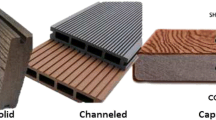Abstract
Carbon–carbon composites have wide applications as ablative insulators. The carbon from thermal destruction of these composites acts as a layer and prevents reduction of volume and destruction of these composite parts. The amounts of carbon and ablation function of these composites are highly dependent on their polymer matrix. Among different thermally resistant polymers, phenolic resins are used extensively in making the insulations due to its low cost and appropriate processing. For production of carbon–carbon ablative composites, some resins with higher content of aromatic carbon and greater remaining carbon yield are used. This research investigates the effect of precursor material and blend composition in preparation and performance analysis of resole-pitch composites prepared through a blending technique. This study aims to investigate the role of each parameter using statistical analysis and modeling for investigation of design and optimization of the composite. The factorial methodology is used to optimize the carbon yield by implementing general factorial design considering the main parameters. The results of this study showed that the carbon yield and thermal resistance can be improved by polymerization of the resole in the presence of coal tar pitches. Resole polymerization with three types of tar pitches has increased the rate of thermochemical ablation by 24.30 %, although density of the carbon remaining after heat treatment has increased to some extent. The results of X-ray showed a structure similar to graphite for combination of the resole-pitch after pyrolysis up to 1000 °C, and finally by making the composite parts from synthesized resins and carbon fibers, improvement in thermal resistance of the parts against oxyacetylene flame is evaluated. The results of this research work hold that heat shields produced from the resole-tar and tar mixture provide greater heat resistance than composites produced from the resole. Therefore, the above-mentioned modification has greater ablative activity in the shields.





Similar content being viewed by others
References
Domínguez JC, Oliet M, Alonso MV, Rojo E, Rodríguez F (2013) Structural, thermal and rheological behavior of a bio-based phenolic resin in relation to a commercial resol resin. Indust Crops Prod 42:308–314
Fei J, Li HJ, Fu YW, Qi LH, Zhang YL (2010) Effect of phenolic resin content on performance of carbon fiber reinforced paper-based friction material. Wear 269:534–540
Hsin HW, Peter PC (2010) Degradation kinetics of functionalized novalac resins. Polym Degrad Stabil 95:1849–1855
Paydayesh A, Kokabi M (2015) Highly filled organoclay/phenolic resin nanocomposite as an ablative heat shield material. Iran Polym J 24:389–397
Abadie JM, Voytekunas VY, Rusanov AL (2006) State of the art organic matrices for high performance composites: a review. Iran Polym J 15:65–77
Baharvand H, Rahimi A (2006) Dispersion pathway on increasing toughness of epoxy resins. Iran Polym J 15:163–168
Murdie N, Marsh H, Heintz EA, Rodriguez-Reinoso F (1997) Introduction to carbon technologies. Universidad Alicante, Alicante, pp 597–633
Raval DK, Narola BN, Patel AJ (2005) Synthesis, characterization and composites from resorcinol-urea-formaldehyde-casein resin. Iran Polym J 14:775–784
Haddadi V (1996) Morphology and properties of conductive carbon/polyolefins composite. Iran Polym J 5:75–86
Kobaycarboni K, Sugawara S, Toyoda S, Honda H (1968) An X-ray diffraction study of phenol–formaldehyde resin carbons. Carbon 6:359–363
Bahramian AR, Astaneh RA (2014) Improvement of ablation and heat shielding performance of carbon fiber reinforced composite using graphite and kaolinite nanopowders. Iran Polym J 23:979–985
Bahramian AR (2013) Effect of external heat flux on the thermal diffusivity and ablation performance of carbon fiber reinforced novolac resin composite. Iran Polym J 22:579–589
Staggs JEJ (2000) Simple mathematical model of char–froming polymers. Polym Int 49:1147–1152
Kassebi F, Mammadov B, Mohammadian S (2012) Preparation, acid curing, and thermal stability of various formulated phenolic resole resins: unfilled and nanocomposites. Int J Polym Mater Polym Biomat 61:323–340
Kasahara N, Shiraishi S, Oya A (2002) Heterogeneous graphitization of thin carbon fiber derived from phenol–formaldehyde resin. Carbon 411:1645–1687
Jin L, Zhou X, He X, Haoquan H (2014) Integrated coal pyrolysis with methane aromatization over Mo/HZSM-5 for improving tar yield. Fuel 114:187–190
Jigang Haigun J, Nau J (2009) Study on the pyrolysis of phenol-formaldehyde resin and modified PF resin. Thermochim Acta 496:136–142
Benk A (2010) Utilisation of the binders prepared from coal tar pitch and phenolic resins for the production metallurgical quality briquettes from coke breeze and the study of their high temperature carbonization behavior. Fuel Proc Technol 91:1152–1161
Kulakov V, Betretdinova L, Kuteinikov AF, Mashkova LA, Serkina GV, Stepanova AN, Tsiruleva IM (1984) An investigation of the chemical interactions of the components in pitch-polymer mixtures. Solid Fuel Chem 18:130–134
Zarate CN, Aranguren MI, Reboredo MM (2008) Thermal degradation of a phenolic resin, vegetable fibers, and derived composites. J Appl Polym Sci 107:2977–2985
Machnikowski J, Rutkowski P, Diez MA (2006) Co-treatment of novolac- and resole-type phenolic resins with coal-tar pitch for porous carbon. J Anal Appl Pyrolysis 76:80–87
Klimova T, Esquivel A, Reyes J, Rubio M, Bokhimi X, Aracil J (2006) Factorial design for the evaluation of the influence of synthesis parameters upon the textural and structural properties of SBA-15 ordered materials. Micro Meso Mater 93:331–343
Su J, Lua A (2006) Influence of carbonization parameters on the transport properties of carbon membranes by statistical analysis. J Membr Sci 278:335–343
Schulze T, Magerl R, Streck G, Brack W (2012) Use of factorial design for the multivariate optimization of polypropylene membranes for the cleanup of environmental samples using the accelerated membrane-assisted cleanup approach. J Chromatogr A 1225:26–36
Warner S, Costenoble S (2013) Finite mathematics and applied calculus, 6th edn, ISBN-13: 978-1133607700
Author information
Authors and Affiliations
Corresponding author
Rights and permissions
About this article
Cite this article
Pirouzfar, V., Mosalmani, M. & Mortezaei, M. Experimental study, modeling and optimization to improve heat resistance of modified resole-pitch composites. Iran Polym J 24, 829–836 (2015). https://doi.org/10.1007/s13726-015-0371-y
Received:
Accepted:
Published:
Issue Date:
DOI: https://doi.org/10.1007/s13726-015-0371-y




